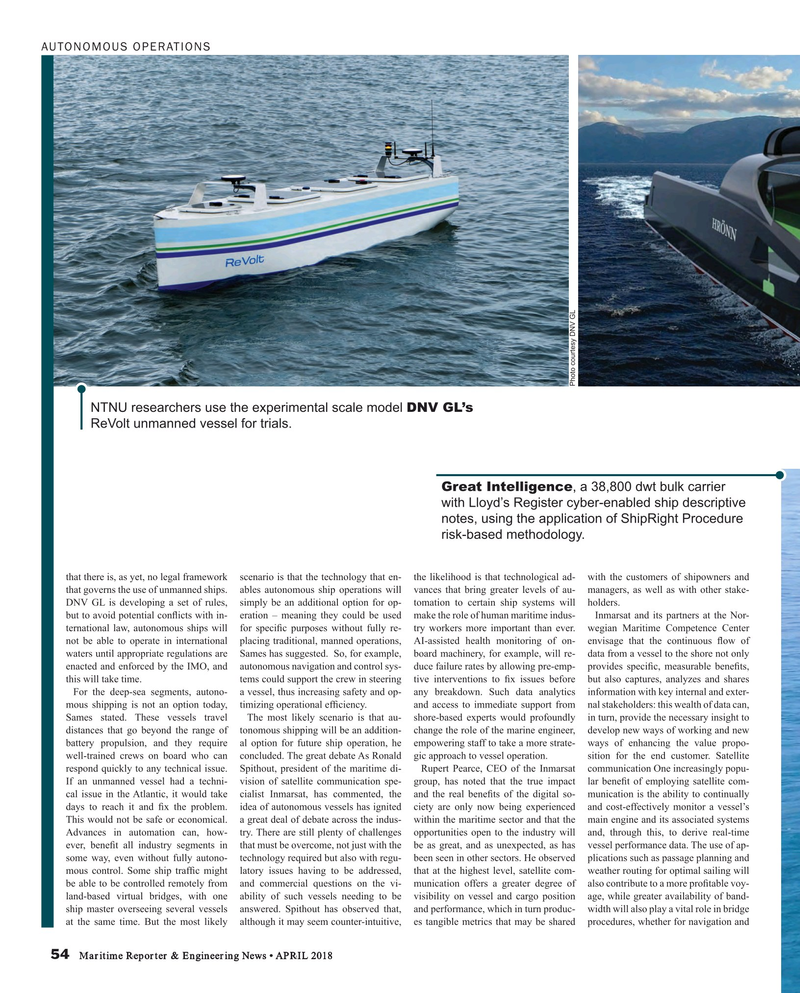
Page 54: of Maritime Reporter Magazine (April 2018)
Offshore Energy Annual
Read this page in Pdf, Flash or Html5 edition of April 2018 Maritime Reporter Magazine
AUTONOMOUS OPERATIONS
Photo courtesy DNV GL
NTNU researchers use the experimental scale model DNV GL’s
ReVolt unmanned vessel for trials.
Great Intelligence, a 38,800 dwt bulk carrier with Lloyd’s Register cyber-enabled ship descriptive notes, using the application of ShipRight Procedure risk-based methodology.
that there is, as yet, no legal framework scenario is that the technology that en- the likelihood is that technological ad- with the customers of shipowners and that governs the use of unmanned ships. ables autonomous ship operations will vances that bring greater levels of au- managers, as well as with other stake-
DNV GL is developing a set of rules, simply be an additional option for op- tomation to certain ship systems will holders. but to avoid potential con? icts with in- eration – meaning they could be used make the role of human maritime indus- Inmarsat and its partners at the Nor- ternational law, autonomous ships will for speci? c purposes without fully re- try workers more important than ever. wegian Maritime Competence Center not be able to operate in international placing traditional, manned operations, AI-assisted health monitoring of on- envisage that the continuous ? ow of waters until appropriate regulations are Sames has suggested. So, for example, board machinery, for example, will re- data from a vessel to the shore not only enacted and enforced by the IMO, and autonomous navigation and control sys- duce failure rates by allowing pre-emp- provides speci? c, measurable bene? ts, this will take time. tems could support the crew in steering tive interventions to ? x issues before but also captures, analyzes and shares
For the deep-sea segments, autono- a vessel, thus increasing safety and op- any breakdown. Such data analytics information with key internal and exter- mous shipping is not an option today, timizing operational ef? ciency. and access to immediate support from nal stakeholders: this wealth of data can,
Sames stated. These vessels travel The most likely scenario is that au- shore-based experts would profoundly in turn, provide the necessary insight to distances that go beyond the range of tonomous shipping will be an addition- change the role of the marine engineer, develop new ways of working and new battery propulsion, and they require al option for future ship operation, he empowering staff to take a more strate- ways of enhancing the value propo- well-trained crews on board who can concluded. The great debate As Ronald gic approach to vessel operation. sition for the end customer. Satellite respond quickly to any technical issue. Spithout, president of the maritime di- Rupert Pearce, CEO of the Inmarsat communication One increasingly popu-
If an unmanned vessel had a techni- vision of satellite communication spe- group, has noted that the true impact lar bene? t of employing satellite com- cal issue in the Atlantic, it would take cialist Inmarsat, has commented, the and the real bene? ts of the digital so- munication is the ability to continually days to reach it and ? x the problem. idea of autonomous vessels has ignited ciety are only now being experienced and cost-effectively monitor a vessel’s
This would not be safe or economical. a great deal of debate across the indus- within the maritime sector and that the main engine and its associated systems
Advances in automation can, how- try. There are still plenty of challenges opportunities open to the industry will and, through this, to derive real-time ever, bene? t all industry segments in that must be overcome, not just with the be as great, and as unexpected, as has vessel performance data. The use of ap- some way, even without fully autono- technology required but also with regu- been seen in other sectors. He observed plications such as passage planning and mous control. Some ship traf? c might latory issues having to be addressed, that at the highest level, satellite com- weather routing for optimal sailing will be able to be controlled remotely from and commercial questions on the vi- munication offers a greater degree of also contribute to a more pro? table voy- land-based virtual bridges, with one ability of such vessels needing to be visibility on vessel and cargo position age, while greater availability of band- ship master overseeing several vessels answered. Spithout has observed that, and performance, which in turn produc- width will also play a vital role in bridge at the same time. But the most likely although it may seem counter-intuitive, es tangible metrics that may be shared procedures, whether for navigation and 54 Maritime Reporter & Engineering News • APRIL 2018
MR #4 (50-58).indd 54 MR #4 (50-58).indd 54 4/6/2018 11:16:48 AM4/6/2018 11:16:48 AM

 53
53

 55
55
